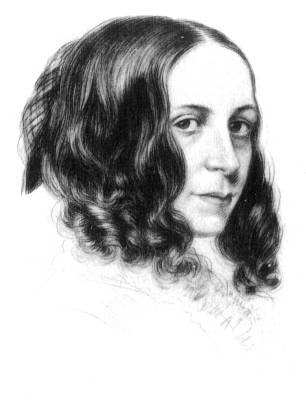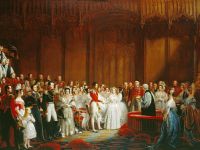
Elizabeth Barrett Browning (1806-1861)
How Do I Love Thee?
How do I love thee?
Let me count the ways.
I love thee to the depth and breadth and height
My soul can reach, when feeling out of sight
For the ends of being and ideal grace.
I love thee to the level of every day’s
Most quiet need, by sun and candle-light.
I love thee freely, as men strive for right.
I love thee purely, as they turn from praise.
I love thee with the passion put to use
In my old griefs, and with my childhood’s faith.
I love thee with a love I seemed to lose
With my lost saints. I love thee with the breath,
Smiles, tears, of all my life; and, if God choose,
I shall but love thee better after death.
— Sonnet XLIII
Elizabeth Barrett Browning‘s poetry was widely popular in both England and the United States during her lifetime and ever since. Actually she was one of the most prominent poets of the Victorian era. Among her most famous works are her Sonnets, of which I especially like one above. Empathetic due to her own lifelong physical sufferings but evocative of profound intellectual thought, Browning’s poems are considered among the greatest contributions to English poetry for the nineteenth century.
Elizabeth Barrett Browning – First Poetry
As the eldest of 12 children, Elizabeth Barrett was born in 1806 in England. Her father Edward Moulton Barrett had accumulated great wealth from his Jamaican sugar plantations. Elizabeth benefited from her privileged life as a child. She was educated at home and attended lessons with her brothers’ tutor. It was said that she was an intensely studious, precocious child. Actually she claimed that at six she was reading novels, at eight she was entranced by Pope’s translations of Homer, studying Greek at ten and writing her own Homeric epic ‘The Battle of Marathon‘. Her mother compiled early efforts of the child’s poetry into collections of “Poems by Elizabeth B. Barrett“.
Stricken with Illness
Unfortunately Elizabeth was stricken with illness around the age of fifteen. A course of opium was prescribed for medical reasons, but it should become a lifelong habit. Despite a nervous collapse, a period of grief occasioned by the untimely deaths of two brothers, a lifetime of illness, and the domination of her father, she continued to write poetry and essays about politics and social injustices.
Escape to Florence
In 1846 she escaped her father‘s control to Florence, Italy, with Robert Browning, to whom she dedicated her best-known book, Sonnets from the Portuguese, published in 1850. It is a set of 44 love poems recording the growth of her love for the poet Robert Browning, who first admired her poetry, then became her friend, and finally her husband. He often called Elizabeth “my little Portuguese” because of her dark complexion. After their marriage, they moved to Italy, where her health markedly improved and she gave birth to a son.
“If thou must love me, let it be for nought
Except for love’s sake only.”
— Sonnets from the Portuguese (1850)
A True Daughter of her Age
Years later modernist author Virginia Woolf (1882–1941) [1] called Elizabeth Barrett Browning ‘the true daughter of her age.’ Woolf‘s praise attracted many modern readers to Elizabeth Barrett Browning‘s work. In the same way, Emily Dickinson (1830–1886) [2] names Elizabeth as her primary inspiration, who admired her as a woman of achievement. No other 19th century female poet was more esteemed than Elizabeth Barrett Browning. Her popularity in the United States and Britain was further advanced by her stands against social injustice, including slavery in the United States, injustice toward Italian citizens by foreign rulers, as well as child labour. Browning is considered a great poet of English literature of the Victorian Age. Her works are tender and delicate, but marked by deep thoughts. Her own suffering, together with her intellectual and moral strength, has made her the heroine of the suffering
Later Years
On her numerous travels, Elizabeth met her idol George Sand, to whom she had dedicated sonnets, in Paris in 1852. In 1857 her epic novel Aurora Leigh was published. In 1850 her perhaps most famous work, Sonnets from the Portuguese with love poems, appeared. Especially famous is How do I love thee? Let me count the ways in which I love you. In 1860 a collected work with her poems was published. She died in Florence in the arms of her husband on June 29, 1861, at age 55, and is buried on the Cimitero degli Inglesi.
Isobel Armstrong, The life and work of Elizabeth Barrett Browning, [8]
References and Further Reading:
- [1] Virginia Woolf and the Birth of Modern Literature, SciHi Blog, January 25, 2014.
- [2] The Poems of Emily Dickinson, SciHi Blog, May 15, 2013.
- [3] Alison Flood, Elizabeth Barrett Browning’s five best poems, The Guardian, March 6, 2014.
- [4] Elizabeth Barrett Browning at Poetry Foundation
- [5] Glen Everett, The Life of Elizabeth Barrett Browning, at The Victorian Web
- [6] Elizabeth Barrett Browning at Wikidata
- [7] Works of Elizabeth Barrett Browning at Wikisource
- [8] Isobel Armstrong, The life and work of Elizabeth Barrett Browning, The British Academy @ youtube
- [9] Works by or about Elizabeth Barrett Browning at Internet Archive
- [10] Angela Leighton (1986). Elizabeth Barrett Browning. Indiana University Press
- [11] Linda M. Lewis (January 1998). Elizabeth Barrett Browning’s spiritual progress: face to face with God. University of Missouri Press.
- [12] Elizabeth Barrett Browning; Mary Rose Sullivan; Mary Russell Mitford; Meredith B. Raymond (1983). The letters of Elizabeth Barrett Browning to Mary Russell Mitford, 1836–1854. Armstrong Browning Library of Baylor University.
- [13] Timeline for Elizabeth Barret Browning, via Wikidata





